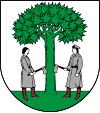Jaworzno
| Jaworzno | |||
|---|---|---|---|

Main Square in Jaworzno
|
|||
|
|||
| Motto: Jaworzno - źródło energii. Jaworzno - the source of energy. |
|||
| Coordinates: 50°8′N 19°16′E / 50.133°N 19.267°E | |||
| Country | Poland | ||
| Voivodeship | Silesian | ||
| County | city county | ||
| Established | 1229 | ||
| Town rights | 1901 | ||
| Government | |||
| • Mayor | Paweł Silbert | ||
| Area | |||
| • City | 152.2 km2 (58.8 sq mi) | ||
| Population (2008) | |||
| • City | 94,580 | ||
| • Density | 620/km2 (1,600/sq mi) | ||
| • Urban | 2,746,000 | ||
| • Metro | 4,620,624 | ||
| Time zone | CET (UTC+1) | ||
| • Summer (DST) | CEST (UTC+2) | ||
| Postal code | 43-600 to 43-618 | ||
| Area code(s) | +48 32 | ||
| Car plates | SJ | ||
| Website | http://www.jaworzno.pl/ | ||
Jaworzno [jaˈvɔʐnɔ] is a city in southern Poland, near Katowice. It lies in the Silesian Highlands, on the Przemsza river (a tributary of the Vistula). Jaworzno belongs to the historic province of Lesser Poland. The city is situated in the Silesian Voivodeship since its formation in 1999, previously (1975 - 1999) it was in Katowice Voivodeship. Jaworzno is one of the cities of the 2,7 million conurbation - Katowice urban area and within a greater Silesian metropolitan area populated by about 5,294,000 people. The population of the city is 95,520 (2008).
The municipality is situated a short distance to the north-east of Junction 41 on the A4 Highway. It lies in the Silesian Highlands, in the historical region of Lesser Poland, and since its foundation until 1975, it was administratively tied with Lesser Poland's capital, Kraków. Until 1795, it belonged to Kraków Voivodeship, then, together with Kraków, was seized by the Habsburg Empire in the Partitions of Poland. In 1815 - 1846 it belonged to the Free City of Kraków, which was annexed by Austria and merged with Kingdom of Galicia and Lodomeria. In 1918 Jaworzno returned to Poland. The name of the city comes from the jawor trees (sycamore maple), which in the past were abundant in this area.
...
Wikipedia



